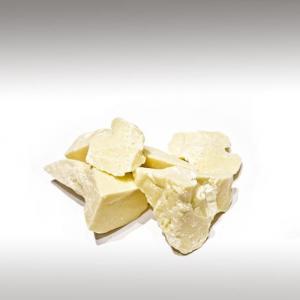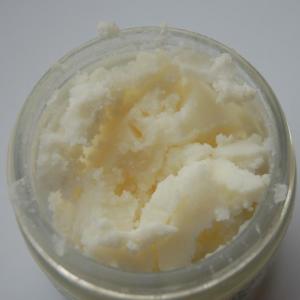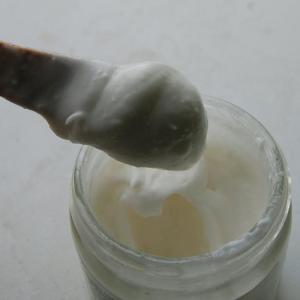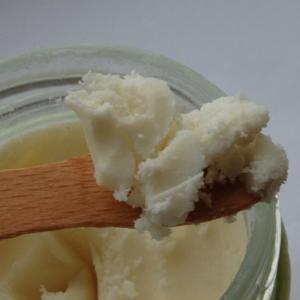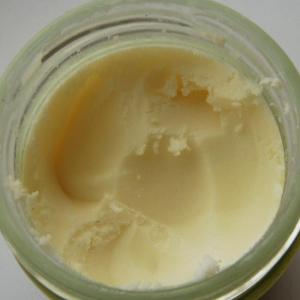
SHEA BUTTER (BUTYROSPERMUM PARKII) - BASE OILS

BASE / GENERAL DATA
Information submited: September 16, 2014 Modified: May 9, 2018 By: OperaDreamhouse
Vitellaria Paradoxa (formerly Butyrospermum Parkii), commonly known as Shea tree, Shi tree or Vitellaria, is a tree of the Sapotaceae family. It is the only species in genus Vitellaria, and is indigenous to Africa.
The Shea fruit consists of a thin, tart, nutritious pulp that surrounds
a relatively large, oil-rich seed from which Shea Butter is extracted.
The common name is Shíyiri or Shísu in the Bambara language of Mali. This is the origin of the English word, and is pronounced "Shee" to rhyme with "Tea". The tree is called Ghariti in the Wolof language of Senegal, which is the origin of the French name of the tree and the butter, Karité. In Hausa language the tree is called Kade or Kadanya.
The Shea tree is a traditional African food plant. The tree starts bearing its first fruit when it is 10 to 15 years old, full production is attained when the tree is about 20 to 30 years old. It then produces nuts for up to 200 years.
The Shea tree grows naturally in the wild in the dry savannah belt of West Africa from Senegal in the west to Sudan in the east, and onto the foothills of the Ethiopian highlands. It occurs in 19 countries across the African continent, namely Benin, Burkina Faso, Cameroon, Central African Republic, Chad, Ethiopia, Ghana, Guinea Bissau, Côte d'Ivoire, Mali, Niger, Nigeria, Senegal, Sierra Leone, Sudan, Togo,Uganda, Democratic Republicof the Congo, and Guinea.
A testa found at the site of the medieval village of Saouga is evidence of Shea Butter production by the 14th century.
The United States Agency for International Development, Gassel Consulting, and many other companies have suggested a classification system for Shea Butter separating it into five grades: A (raw or unrefined, extracted using water), B (refined), C (highly refined and extracted with solvents such as hexane), D (lowest uncontaminated grade), E (with contaminants).
The color of raw (grade A) butter ranges from cream (like whipped butter) to grayish yellow, and it has a nutty aroma which is removed in the other grades.
Grade C is pure white. While the level of vitamin content can be affected by refining, up to 95% of vitamin content can be removed from refined grades of Shea Butter while reducing contamination levels to non-detectable levels.
Chemical structure:
Shea Butter is composed of five principal fatty acids: palmitic, stearic, oleic, linoleic, and arachidic. About 85 to 90% of the fatty acid composition is stearic and oleic acids. The relative proportion of these two fatty acids affects Shea Butter consistency. The stearic acid gives it a solid consistency, while the oleic acid influences how soft or hard the Shea Butter is, depending on ambient temperature.
The proportions of stearic and oleic acids in the Shea kernels and Butter differ across the distribution range of the species. Ugandan Shea Butter has consistently high oleic acid content, and is liquid at warm ambient temperatures. It fractionizes into liquid and solid phases, and is the source of liquid Shea oil.
Thefatty acidproportion of West African Shea Butter is much more variable than Ugandan Shea Butter, with an oleic content of 37 to 55%. Variability can be high even locally, and a tree that produces hard butter can grow with one that produces soft butter. Nuts are gathered from a wide area for local production, so Shea Butter consistency is determined by the average fatty acid profile of the population. Within West Africa, Shea Butter from the Mossi Plateau region of Burkina Faso has a higher average stearic acid content, and so is usually harder than Shea Butter from other West African regions.
It has a high lipid profile, also containing beneficial phytochemicals (Vitamin A). It also contains oleic acid (omega - 9 monounsaturated fatty acid).
The common name is Shíyiri or Shísu in the Bambara language of Mali. This is the origin of the English word, and is pronounced "Shee" to rhyme with "Tea". The tree is called Ghariti in the Wolof language of Senegal, which is the origin of the French name of the tree and the butter, Karité. In Hausa language the tree is called Kade or Kadanya.
The Shea tree is a traditional African food plant. The tree starts bearing its first fruit when it is 10 to 15 years old, full production is attained when the tree is about 20 to 30 years old. It then produces nuts for up to 200 years.
The Shea tree grows naturally in the wild in the dry savannah belt of West Africa from Senegal in the west to Sudan in the east, and onto the foothills of the Ethiopian highlands. It occurs in 19 countries across the African continent, namely Benin, Burkina Faso, Cameroon, Central African Republic, Chad, Ethiopia, Ghana, Guinea Bissau, Côte d'Ivoire, Mali, Niger, Nigeria, Senegal, Sierra Leone, Sudan, Togo,Uganda, Democratic Republicof the Congo, and Guinea.
A testa found at the site of the medieval village of Saouga is evidence of Shea Butter production by the 14th century.
The United States Agency for International Development, Gassel Consulting, and many other companies have suggested a classification system for Shea Butter separating it into five grades: A (raw or unrefined, extracted using water), B (refined), C (highly refined and extracted with solvents such as hexane), D (lowest uncontaminated grade), E (with contaminants).
The color of raw (grade A) butter ranges from cream (like whipped butter) to grayish yellow, and it has a nutty aroma which is removed in the other grades.
Grade C is pure white. While the level of vitamin content can be affected by refining, up to 95% of vitamin content can be removed from refined grades of Shea Butter while reducing contamination levels to non-detectable levels.
Chemical structure:
Shea Butter is composed of five principal fatty acids: palmitic, stearic, oleic, linoleic, and arachidic. About 85 to 90% of the fatty acid composition is stearic and oleic acids. The relative proportion of these two fatty acids affects Shea Butter consistency. The stearic acid gives it a solid consistency, while the oleic acid influences how soft or hard the Shea Butter is, depending on ambient temperature.
The proportions of stearic and oleic acids in the Shea kernels and Butter differ across the distribution range of the species. Ugandan Shea Butter has consistently high oleic acid content, and is liquid at warm ambient temperatures. It fractionizes into liquid and solid phases, and is the source of liquid Shea oil.
Thefatty acidproportion of West African Shea Butter is much more variable than Ugandan Shea Butter, with an oleic content of 37 to 55%. Variability can be high even locally, and a tree that produces hard butter can grow with one that produces soft butter. Nuts are gathered from a wide area for local production, so Shea Butter consistency is determined by the average fatty acid profile of the population. Within West Africa, Shea Butter from the Mossi Plateau region of Burkina Faso has a higher average stearic acid content, and so is usually harder than Shea Butter from other West African regions.
It has a high lipid profile, also containing beneficial phytochemicals (Vitamin A). It also contains oleic acid (omega - 9 monounsaturated fatty acid).

SPIRITUAL PRACTISES DATA

MEDICINE / HEALTH DATA

BEAUTY / COSMETICS DATA

FOOD / COOKING DATA
COMMENTS
No comments.
Newest mixtures containing Shea Butter (Butyrospermum Parkii):

Face and body gentle oil cleanser
May 26, 2016

Whipped Shea Butter recipe
September 4, 2015

Softening hand balm
August 19, 2015

Summer time body moisturizer
August 5, 2015

Homemade White Tiger Balm (karpura)
July 30, 2015

Therapeutic body balm for insect bite healing
June 3, 2015

Skin healing balm for winter season
February 23, 2015

Nourishing body butter
February 4, 2015


